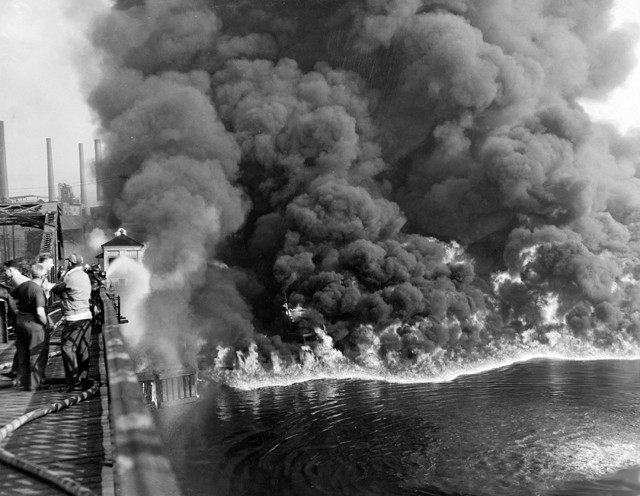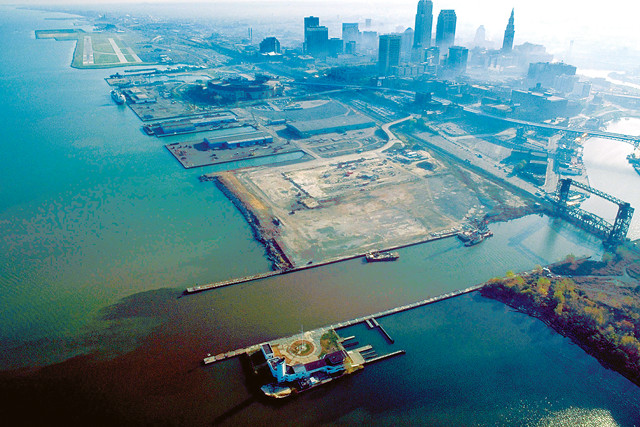
by Meg Marquardt Tuesday, July 5, 2016
It was a relatively small fire. In terms of damage and duration, the city of Cleveland had seen far worse in the 173 years since its founding. In fact, the blaze on June 22, 1969, only warranted a mere 181 words in the Cleveland Plain Dealer. But it was not an ordinary fire: It was the Cuyahoga River that burned. And the event started a movement that revolutionized the United States’ commitment to environmental protection.
The headwaters of the Cuyahoga River are in Geauga County, Ohio, a mere 24 kilometers from Lake Erie. Instead of taking a direct route to the lake, the river meanders more than 160 kilometers west and south, fed by dozens of tributaries until it finally swings north through Cleveland to empty into Lake Erie. Those winding curves earned Cuyahoga its name, which means “crooked river” in Iroquois. The river’s lazy, circuitous route through the Cleveland area makes for beautiful scenery — but it also creates natural nooks in which potentially flammable debris can cluster.
Pollution in the Cuyahoga was a problem as early as the 1860s. By 1881, Cleveland’s mayor proclaimed the waters to be “an open sewer through the center of the city.” As Cleveland entered the Industrial Revolution, steel production and chemical processing factories along the banks of the river added industrial runoff to the waters. Sewage also increased as the city became a center for progress and the population boomed. Lake Erie supplied the city’s drinking water, but the discharge from the polluted Cuyahoga made the lake water near the mouth of the river distasteful for drinking, forcing officials to move the intakes for drinking water farther into the lake.
Despite these problems, there was no immediate push to clean up the Cuyahoga. The river itself was not used for recreation or drinking water. The main concern was whether boats could navigate the channel through the city. Though the oil, chemicals and other debris were unsightly, they didn’t hinder the passage of ships.
Until the fires started.

This image is often attributed to the 1969 fire, but in fact it is the brutal blaze of 1952. Much larger than any other fire on the river, the 1952 conflagration did somewhere between $500,000 to .5 million worth of damage. Credit: Special Collections, Cleveland State University Library.
The first recorded fire on the river was in 1868. Of the fires that followed, a blaze in the spring of 1912 was one of the worst: As a tugboat crossed an oil stream left in the wake of a leaking tanker, there was a spark, and the resulting explosion and fire killed five people. By 1936, fires on the Cuyahoga were so out of control that one lasted for five days. After a fire in 1941 caused $7,500 worth of damage to a ship, city officials began to worry that the river would become unusable as a shipping lane, which would be devastating for the port city’s economy.
Following that fire, the city took a more direct interest in river pollution and prevention of further fires. The city’s fire-prevention measures ranged from fines for dumping to the designation of crews trained in oil cleanup to specific fire hazard guidelines for riverside factories. Despite these endeavors, in 1952, an oil slick in front of the Great Lakes Towing Company’s shipyards produced the most massive fire to date. Loss of property was estimated at anywhere from $500,000 to $1.5 million; had the fire not been on a Sunday, many workers on boats navigating the river would have likely been killed. The fire received front-page coverage in the newspaper, but little attention nationwide.
It was not until 1969 that the Cuyahoga fires caught the notice of the rest of America. The June 22, 1969, fire, most likely started by a stray spark from a train’s wheel as it crossed a bridge over the river, was intense but short-lived. The fire brigade responded to a call that came in at 11:56 a.m. and had the flames under control by 12:20 p.m. — so quickly that no newsreels and almost no cameras caught images of the blaze. Damage totaled about $50,000 and was contained to two train trestles. There were no injuries. For all practical purposes, it was just another fire on the Cuyahoga. Across the nation, however, the story ran a little differently.
Though the 1969 fire was nothing like the conflagration of 1952, awareness about environmental protection was considerably higher in the 1960s — especially where water was concerned — in the wake of Rachel Carson’s landmark 1962 book “Silent Spring.” In fact, states had begun their own environmental movements despite little funding from the federal government. By 1966, most states had some form of review board in place to monitor water pollution. Ohio was among the most progressive states on that front, creating its own monitoring board in 1951.
But without federal action, state environmental initiatives were still at the mercy of the commitment of their neighbors. This was particularly a problem in the Lake Erie region. Cleveland was taking steps to curb the amount of contamination the city sent to the lake, but the manufacturing powerhouse Detroit, sitting just across the lake, contributed seven times more pollution. In 1969, there was already public interest in federal regulation and in uniform requirements for environmental protection. What the movement truly needed was a rallying point. So it wasn’t the size or destructiveness of the Cuyahoga River fire that mattered: It was the news coverage.

The Cuyahoga River in 1992, where the river empties into Lake Erie. Credit: U.S. Army Corps of Engineers.
Though it earned less than a 200-word article buried inside the Cleveland Plain Dealer, the 1969 fire found its way into the pages of Time Magazine. The article painted a less-than-appealing image of the Cuyahoga: “Some river! Chocolate-brown, oily, bubbling with subsurface gases, it oozes rather than flows.” The Cuyahoga and intensely polluted Lake Erie were the focus of the article, but there were also jabs at the lack of federal regulation. The federal government had pledged more than $1.1 billion to update sewage treatments in the region, but only 15 of the 102 major cities along the lake were on schedule for the updated sewage and industrial waste treatment systems. The message the Time article was sending could not be clearer: “The trouble is that pollution rarely gets a high priority until profits are affected or people are killed.”
The burning of the Cuyahoga River and the subsequent Time story helped drive the formation of the federal Environmental Protection Agency (EPA) in 1970 and the Clean Water Act of 1972. The picture that ran with the story became the recurring image of the movement, so much so that future EPA Administrator Carol Browner, who was only 13 at the time of the fire, said in an interview in the late 1990s, “I will never forget a photograph of flames, fire, shooting right out of the water in downtown Cleveland. It was the summer of 1969 and the Cuyahoga River was burning.” That image, however, was not actually of the 1969 fire; it was the 1952 blaze, finally getting national attention almost two decades later.
In 2009, Cleveland held “The Year of the River” on the 40-year anniversary of the river fire. The river’s history through that half century was still a struggle: In 1972, Cuyahoga was devoid of fish in a stretch between Akron and Cleveland, and in 1988, that same stretch was proclaimed one of the most polluted waterways in America. But an EPA survey in 2008 showed that all but the final stretch through Cleveland was coming back to life, with more than 40 species of fish present in waters that were close to meeting Clean Water Act requirements. While cleanup continues, one thing seems certain: The Cuyahoga will not soon catch fire again.
© 2008-2021. All rights reserved. Any copying, redistribution or retransmission of any of the contents of this service without the expressed written permission of the American Geosciences Institute is expressly prohibited. Click here for all copyright requests.